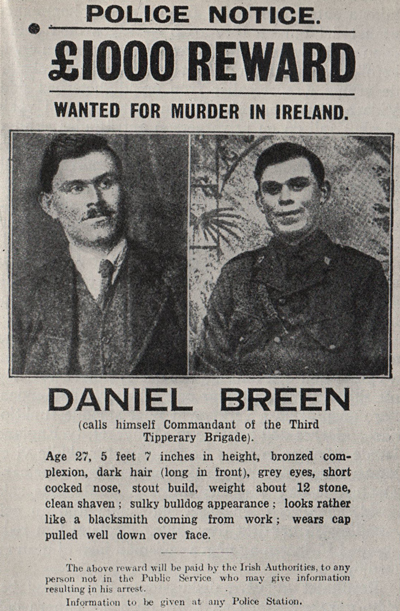“It’s alright, I am Dan Breen”
famous revolutionary fighter captured in Tipperary dug-out amid round-ups of Irregulars
Tipperary, 18 April 1923 - Dan Breen, the famous Irish revolutionary, was captured yesterday by National army troops with two of his ‘Irregular’ companions, in the Glen of Aherlow, Co. Tipperary.
The other men captured have been identified as Maurice Walsh of Mitchelstown and Tim Donovan, Commander of a local company of IRA anti-Treaty soldiers. Mr. Breen and his colleagues were discovered in a dug-out in the Glen of Aherlow by troops of the Limerick Command.
Six rifles and two bombs were found in the dug-out situated on the slopes of a range of hills parallel with the Galtee Mountains and overlooking the Glen of Aherlow not far from the village of Galbally. Breen and the others were caught by surprise and offered no resistance when discovered . They were so caught unaware that they were all in a state of semi-dress.
The National army soldiers had been drawn to site after the discovery of empty cigarette cases on the hillside and on closer inspection they found fresh clay leading to an opening to a dug-out. On hearing voices inside, the troops called on the men inside to surrender only for Dan Breen to come forward, clad only in his trousers and a shirt, declaring: ‘It’s alright, I am Dan Breen.’
Mr. Breen later remarked that he would not have been captured alive only that he wished to spare the lives of his two comrades. All three men shook hands with their captors on surrendering.
Donal Byrne reports for RTÉ News on a ceremony held to commemorate the 100th anniversary of the Soloheadbeg ambush of 21 January 1919. The ambush was led by Dan Breen and Seán Treacy
Dan Breen’s war of independence record is well-known and it is believed that he sustained no fewer than 24 bullet wounds in the course of the campaign. A personal friend of the late Michael Collins, whose killing he regretted, he was also close with Seán Treacy, with whom he fought his way out of a house in Whitehall in October 1920 on being discovered by Crown forces. Mr Treacy was soon after killed in a gunfire exchange with Crown forces on Talbot Street in Dublin.
The capture of Breen and his comrades was not isolated. It occurs during a period when the National army has been engaged in a series of successful round-up operations across the country, but most notably in the south, in places such as Counties Tipperary and Kerry.
It was in the former in a field in the Knockmealdown Mountains just five miles from where Liam Lynch was recently fatally wounded - that the Kerry TD and former Dáil Éireann cabinet minister for home affairs (November 1919 to January 1922), Austin Stack, was captured.
Mr. Stack was unarmed, offered no resistance and while well-dressed, his appearance was somewhat haggard. He has since been transferred to Clonmel.
Mr. Stack was found in possession of a draft memorandum which was intended for signature by all available members of his republican executive. The memorandum, believed to be in Stack’s own handwriting, states that further military efforts would be futile and calls for a general laying down of arms.
[Editor's note: This is an article from Century Ireland, a fortnightly online newspaper, written from the perspective of a journalist 100 years ago, based on news reports of the time.]





















